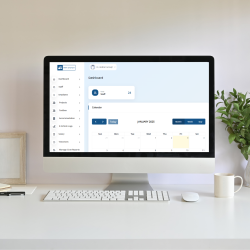The Challenge
Xdoc faces significant challenges in ensuring accurate element detection and image interpretation. When a screenshot is uploaded, the platform relies on AI algorithms to identify key components like buttons, fields, and menus. However, complex or customized designs can be difficult for the AI to accurately interpret, leading to potential misinterpretations or omissions of crucial elements. This requires continuous refinement of the AI to enhance its ability to detect and categorize non-standard components and incorporate them into the final SOP.
Another major challenge is preserving customization and integrating unique features into the SOPs. Many systems include custom UI elements, proprietary navigation flows, or other unique features that may not be easily recognized by the AI. To generate accurate documentation, the platform needs to adapt and account for these specialized components, which may involve custom development, app integrations, or further AI model retraining to ensure that non-standard workflows are properly documented without sacrificing user experience.
Xdoc also struggles with managing large and complex data for bulk imports, particularly when migrating extensive product inventories or intricate interfaces. The platform must ensure that large files containing product data, UI elements, and metadata can be processed quickly, accurately, and without error. Additionally, there is a need for proper formatting and seamless integration of these data elements into the generated SOPs, especially when users need to adjust large-scale elements like product descriptions or images.
Finally, customizing SOPs to meet client-specific needs presents a considerable challenge. While AI-generated SOPs are structured and functional, they may not always align with the client’s branding, tone, or formatting preferences. The platform must allow for flexibility in customization, enabling users to tweak content, layout, and style without disrupting the document’s integrity. This balance between automation and customization, along with handling large files, integrating third-party tools, and ensuring security and privacy for sensitive client data, completes the series of challenges Xdoc faces in delivering efficient, tailored, and secure SOPs. Additionally, integrating a subscription model and building a fully functional, scalable system that can support varying user tiers and workflows is crucial. The platform must ensure that users can access the right features based on their subscription level, while maintaining seamless performance, secure data handling, and the ability to scale as demand grows, ensuring long-term platform success.
A further challenge arises in building a custom Laravel-based system to support the entire Xdoc platform. Since Laravel is a powerful PHP framework, creating a custom, scalable solution with specific features—such as user authentication, subscription management, image processing, and AI integrations—requires a deep understanding of both Laravel and the unique needs of the application. Customizing the Laravel environment to meet the platform’s specific requirements, including secure API integrations, real-time document generation, and smooth user experience design, adds complexity to the project. Ensuring that the custom build is modular, maintainable, and adaptable for future feature upgrades is essential for long-term success.
Kalpesh produced a website for my Finance Consultancy start-up business based in Dubai in Nov-24. I had some very specific requirements for the look and feel based on a theme I was asked to choose. Kalpesh was very responsive in delivering my requirements and was available around the clock to clarify or amend where needed. I’m really happy with the results and hoping its a key part of building my business. Thanks!!!
Simon Fee
Marketing Consultant Expert
The Process
The first step in building the Xdoc platform is thorough planning and setup. This begins with defining the core functionality and purpose of the tool: automating the generation of Standard Operating Procedures (SOPs) from images, particularly interface screenshots and hardware layouts. This requires a detailed understanding of user needs, such as the ability to accurately detect UI elements (buttons, fields, menus) and create structured SOPs. A suitable development environment is chosen, typically a Laravel-based stack or a combination of PHP, AI tools, and frontend frameworks. The planning phase also includes deciding on the subscription model and user tiers, ensuring the platform can scale effectively as demand increases.
Once the foundational setup is complete, the next stage focuses on building the core functionality of the platform. The AI integration is at the heart of Xdoc’s functionality, where AI algorithms are trained or integrated to accurately analyze interface screenshots and hardware images. A deep learning model, potentially based on computer vision techniques, is used to detect UI elements in the images, such as buttons, text fields, and navigation menus. The image processing pipeline is carefully developed to preprocess and analyze the uploaded images, ensuring accurate detection and categorization of key elements. Additionally, a user-friendly interface is designed, where users can easily upload images, highlight elements with a Red Square Box tool, and customize the resulting SOPs. A crucial part of this phase is ensuring scalability for handling bulk uploads and complex images without compromising performance.
The final step in the process focuses on optimization, testing, and launching. This includes performance optimization, where the speed of SOP generation is improved using advanced algorithms and backend optimizations. SEO optimization is also performed for relevant content and documentation. Testing the system’s AI accuracy and ensuring that it can generate error-free SOPs is crucial. A focus is placed on optimizing the backend performance for smooth document creation, even when processing large files or complex layouts. Security and privacy features are integrated, ensuring that user data is securely handled. Once the platform is thoroughly tested, it is officially launched. However, the work doesn’t end there. Ongoing maintenance is essential for continuous improvements, including AI model updates for better element detection, integration of new features, and regular updates for optimal performance. Additionally, user feedback is continuously gathered to fine-tune the platform’s usability and effectiveness.
Conclusion
Xdoc is an innovative platform that leverages advanced AI technology to automate the creation of Standard Operating Procedures (SOPs) from interface screenshots and images. By accurately detecting and categorizing UI elements such as buttons, fields, and menus, Xdoc allows businesses to seamlessly transform visual data into structured, step-by-step documentation. The platform addresses key challenges like customization, bulk data handling, and integration with third-party tools, while ensuring ease of use, scalability, and security. With flexible subscription models and continuous improvements, Xdoc offers a powerful solution for businesses to streamline their documentation processes, improve workflow efficiency, and maintain consistency across complex systems and interfaces.
Let’s Make Things Happen
Curabitur ac leo nunc. Vestibulum et mauris vel ante finibus maximus nec ut leo. Integer consectetur.
“The team at Avada Marketing Consultant is fabulous. They helped us unlock our potential online and offline. We have experienced year on year growth due to their progressive approach.”
George Anderson
Digitalbox CEO







